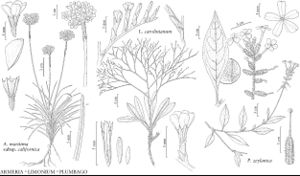Limonium
Gard. Dict. Abr. ed. 4, vol. 2. 1754.
| Taxon | Illustrator ⠉ | |
|---|---|---|
 | Armeria maritima Limonium carolinianum Plumbago zeylanica | John Myers John Myers John Myers |
Plants herbs, usually perennial, scapose, acaulescent; taprooted or rhizomatous. Leaves basal (sometimes also on inflorescence axes), sessile or petiolate; blade often punctate, elliptic to obovate, oblanceolate, spatulate, oblong, or round, usually coriaceous, base usually long-attenuate, margins entire or toothed to pinnatifid, apex rounded to apiculate or retuse. Inflorescences usually of terminal panicles or corymbs, ultimate branch tips bearing secund, usually 1–3 (–5) -flowered spikelets. Pedicels absent or present (very short, subtended by 3 or 4 sheathing bracts). Flowers homostylous; calyx tubular to funnelform, 5-ribbed, glabrous or pubescent, plicate, lobes oblong to triangular, sometimes with smaller intervening lobes, or lobes ± connate and calyx mouth erose; petals nearly distinct, white, lavender, or yellow, long-clawed; filaments adnate to base of corolla; anthers included; styles 5, distinct to base; stigmas linear-clavate, papillate. Fruits utricles, usually exserted from persistent calyx, brownish green, usually capped by marcescent corolla and style bases. x = 8, 9.
Distribution
Worldwide, especially from Mediterranean region east to c Asia
Discussion
Species ca. 300 (8 in the flora).
The greatest diversity in Limonium is found in Europe (ca. 100 species and many subspecies; see S. Pignatti 1972) and in Mediterranean and central Asian regions, often on saline or calcareous soils and cliffs near the coasts; other species are found in saline marshlands. The showiest species (L. arborescens and L. perezii), with a persistent blue-purple to lavender calyx, have their origin in the Canary Islands; they are often cultivated for ornament or their inflorescences are air-dried for floral arrangements under their Linnaean name “Statice.” Other species have been used in rock gardens. Six species are locally naturalized in California.
Limonium vulgare Miller (Statice limonium Linnaeus), similar morphologically to L. carolinianum, has been reported by H. J. Scoggan (1978–1979, part 4) from central Saskatchewan and southern Ontario (“in a weedy...cemetery...York Co., where ‘growing without cultivation’”). It is doubtful that the species persists or is spreading. Recent revisitation of the site in Ontario by J. E. Eckenwalder (pers. comm.) suggests that Limonium vulgare is no longer extant there. Limonium leptostachyum (Boissier) Kuntze (S. leptostachya Boissier) has been reported from New York by R. S. Mitchell and G. C. Tucker (1997); it is doubtful that this central Asian species is naturalized in the flora area. It differs from all other species in the flora area by having small (10–30 × 5 mm), deeply pinnatifid leaves and narrow, spikelike inflorescences.
Some species of Limonium, e.g., L. sinuatum, have dimorphic pollen and stigmas that result in self-incompatibility, although the native species in the flora area have been shown to be self-compatible (H. G. Baker 1953b). Agamospermy is also common in some extraterritorial species, and this may account, in part, for the taxonomic difficulty in some groups of Limonium.
Selected References
Lower Taxa
Key
| 1 | Leaf blade margins pinnately lobed; inflorescence axes with 3-5 wings, these with linear leaflike appendages 2-8 × 0.2-0.5 cm and stiff, stout hairs to ca. 1.5 mm | Limonium sinuatum |
| 1 | Leaf blade margins ± entire or obscurely undulate; inflorescence axes not winged, or if winged, then wings 2(-3), linear leaflike appendages absent, glabrous | > 2 |
| 2 | Inflorescences with some nonflowering branches | Limonium otolepis |
| 2 | Inflorescences with all (or nearly all) branches bearing flowers | > 3 |
| 3 | Inflorescences greater than 1 m, axes strongly winged, wings leaflike, veined | Limonium arborescens |
| 3 | Inflorescences less than 1 m, axes not winged | > 4 |
| 4 | Calyces blue-purple distally; leaf blades round to broadly ovate or subcordate, bases abruptly narrowed, nearly as broad as long; floral bracts ciliate or fimbriate on margins; coastal s California | Limonium perezii |
| 4 | Calyces whitish distally; leaf blades obovate to oblong or oblanceolate, bases gradually tapered; floral bracts glabrous at margins; widespread | > 5 |
| 5 | Leaf blades less than 4 × 1.5 cm, each with single midrib and sometimes 2 lesser, ± parallel veins; petals pink to lavender, exserted 2-3 mm from calyx;calyx ribs glabrous; coastal salt marshes of s California | Limonium ramosissimum |
| 5 | Leaf blades more than 4 × 1.5 cm, pinnately veined; petals lavender or whitish, exserted 0-2 mm from calyx; calyx ribs often pilose, sometimes glabrous; widespread | > 6 |
| 6 | Calyx lobes spreading at maturity; spikelets always densely aggregated at tips of inflorescence branches; inland alkaline areas | Limonium limbatum |
| 6 | Calyx lobes ascending or erect at maturity; spikelets not aggregated, or loosely to moderately or densely aggregated along inflorescence branches; coastal salt marshes or flats | > 7 |
| 7 | Spikelets loosely to moderately densely aggregated along inflorescence branches; leaf blade apices cuspidate, cusps 1-3 mm,soon falling; Atlantic and Gulf coastal plains | Limonium carolinianum |
| 7 | Spikelets moderately to densely aggregated along inflorescence branches; leaf blade apices rounded or, occasionally, retuse at tips, rarely cuspidate (cusps less than 0.5 mm); California and Oregoncoasts, Arizona, s Nevada | Limonium californicum |